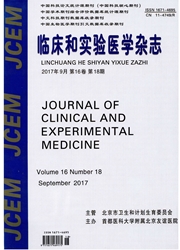

 中文摘要:
中文摘要:
目的研究胃肠道间质瘤(GIST)的临床病理特点,探讨其危险性分级与临床因素关系。方法对40例胃肠道间质瘤的临床及病理资料进行复习,结合形态学特点及免疫组化指标诊断,根据NIH标准进行危险性分级,并进行相关的统计学分析。结果 40例胃肠道间质瘤中,17例为极低和低危险性,23例为中和高危险性,极低与低危险性组与中度与高度危险性组在肿瘤大于和小于等于5 cm,Ki67大于和小于等于5%,核分裂像大于和小于等于5个/50HPF分组中比较差异有统计学意义(P〈0.05,P〈0.01),在年龄、性别及肿瘤来源部位分组比较中差异无统计学意义(P〉0.05)。结论 CD117、CD34及Dog-1等是GIST病理诊断的重要免疫组化标记物,GIST危险性分级与肿瘤大小、核分裂像和Ki67关系密切,是判断GIST生物学行为重要的因素。
 英文摘要:
英文摘要:
Objective To study the clinicopathological characteristics and immunohistochemical features of gastrointestinal stromal tumors ( GIST), and to explore the relationship between risk grades and biological behavior. Methods According to NIH criteria, the risk grades were determined by combining immunohistochemical and morphological features. The clinicopathological features of 40 cases of gastrointestinal stromal tumors were analyzed. Results In 40 cases of GIST, mitotic count, tumor size and positive Ki - 67 were significantly higher in moderate and high risk groups than those in very low and low risk groups ( P 〈0.05, P 〈0.01). There was no significant difference in age, sex and tumor size ( P 〉 0.05). Conclusion CDl17, CD34 and Dog- 1 were important immunohistochemical markers in pathological diagnosis of GrST. The risk grade of GIST was closely related with tumor size, mitotic count and positive Ki67. They are important factors to judge biological behavior of GIST.
 同期刊论文项目
同期刊论文项目
 同项目期刊论文
同项目期刊论文
 期刊信息
期刊信息
